Nokia Lumia 930 Review
by Brett Howse on September 8, 2014 3:00 PM EST- Posted in
- Smartphones
- Microsoft
- Nokia
- Mobile
- windows phone
- Lumia
Display
The Lumia 930 packs a 5” 1920x1080 resolution AMOLED display into its chassis. As seems to be the norm for higher resolution AMOLED, the Lumia 930 uses a RGBG Pentile matrix. AMOLED seems to have a lot more issues with color reproduction than most LCD displays, but the recent showing from Samsung with the Galaxy S5 and especially the Galaxy S5 LTE-A model have proven that an accurate AMOLED display can be done. The question is if it was done in this case. As display quality is one thing that can still differentiate one device from another, it is an important point. No part of a smartphone is used more than the display.
The latest Lumia devices with the Nokia “Cyan” firmware offer more customization of display settings than ever before, with fully adjustable brightness, and the ability to adjust color temperature, tint, and saturation. This is a huge step forward, but the hope is that the display can be accurate out of the box as well.
Like the Lumia 630 we recently looked at, the Lumia 930 also supports Nokia’s ClearBlack technology for better outdoor viewing and better black levels due to a reduction in reflections in the display layers. In addition, the device has Corning Gorilla Glass 3, a high brightness mode for outdoor viewing, and a second enhancement for outdoor viewing which Nokia calls “Sunlight readability enhancements” and is a method of performing content-adaptive backlight control (CABC) to adjust the perceived brightness of an image, but rather than doing full-frame CABC which is the common method of doing this, Nokia’s implementation utilizes Assertive Display technology from Apical. Rather than perform the CABC on an entire image, Assertive Display performs the adjustment on a per-pixel level. This can dramatically increase the usability of a display in bright sunlight and it does so without necessarily using more display power. Below is a sample of the Lumia 930 with the feature both on and off.
 Sunlight Readbility Off (upper picture) vs On (lower picture)
Sunlight Readbility Off (upper picture) vs On (lower picture)
This photo is somewhat of a worst case scenario, with a very dark image outside under the full sun. The bottom image is with the Sunlight Readability Mode enabled, and you can see that more of the image is visible.
To test the display accuracy, we turn to Spectralcal’s CalMAN 5 software package with a custom workflow. We utilize the X-Rite i1Pro Spectrophotometer for color accuracy and saturation, and the X-Rite i1Display Pro for contrast ratios. As this is an AMOLED display, we generally ignore the contrast ratios and black levels since the black level of AMOLED is zero, meaning the contrast ratio for all AMOLED displays is infinite.
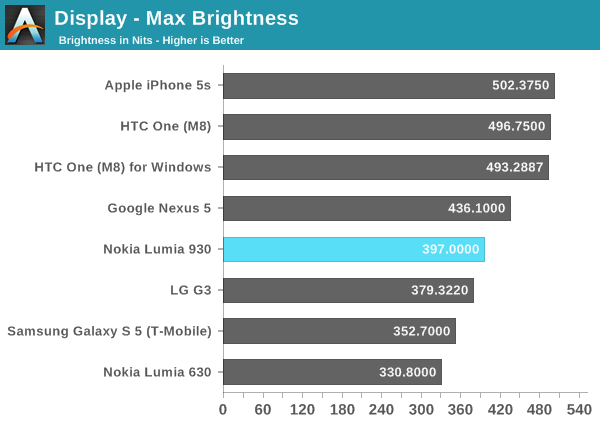
The maximum brightness is very good for an AMOLED device at around 400 nits. Other 1080p AMOLED displays include the Galaxy S5, which only comes in at 350 nits. The maximum output was achieved in the outdoor viewing mode, with normal brightness levels kept much lower. It is a good result for this type of display and certainly helps with the phone being able to be used outdoors.
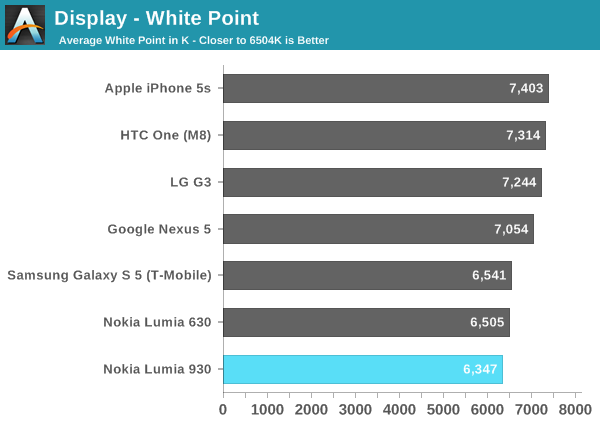
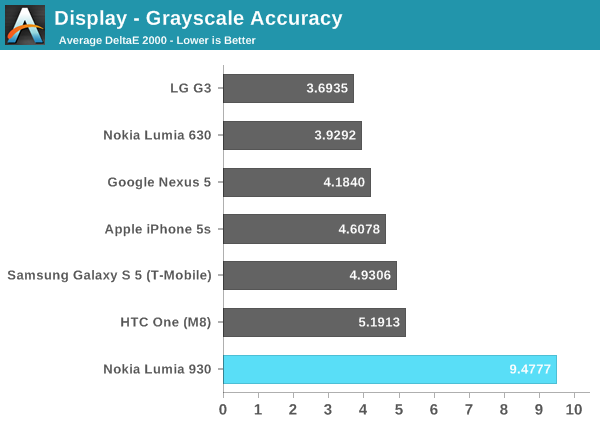
Now we can start to see some issues with the Nokia’s implementation of this AMOLED display. White Point is pretty good at 6347. What is missing though is green, which starts to drop off almost immediately after 5 to 10% white level, and then continues to fall right up until 100%. This leads to a grayscale average dE2000 of 9.4777 with the upper scores causing most of the issues. The grayscale almost perfectly follows an inverse of the green levels in the overall image.

Saturation accuracy is also not fantastic, with a dE2000 average of 6.6579. It is not helped either with the grayscale being so far off, which really pulls this score up. But regardless of grayscale, the saturation sweeps show all of the colors are off.
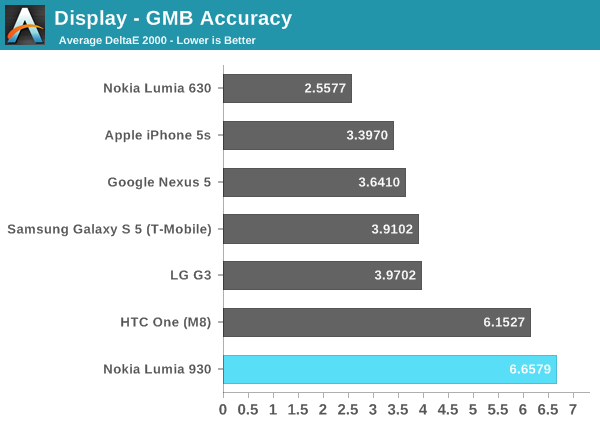
Like the saturation sweeps, the Gretag Macbeth color checker also has a dE2000 average of over 6, which is not great. There is really nothing here to focus in on as being well done. Out of the box, there is clearly no effort put in to calibrate the display at the factory which is a shame because other competitors are putting this effort in.
Adjusted Display
As part of the Nokia firmware updates, we can finally adjust the individual aspects of the display now. Not only can brightness be adjusted on a slider, but color temperature can be adjusted from warm to cool, tint can be adjusted from green to purple, and color saturation can be adjusted from neutral to vivid. This allows us to compensate for the lack of green and try to get the display into a much more accurate mode. While not a true color management system, it is certainly better than no options, or just generic options like “cinema mode” or other such methods of changing the profile of the display.
I performed some adjustments of the tint in order to pull the green values up, and the results were much better. While the white point was increased to 7006, the green values averaged much closer to 100 with this adjustment. Grayscale was still not perfect at 4.03, but it was much better than the initial results of 9.477. Saturation accuracy improved dramatically to 3.6781, and the Gretag Macbeth came all the way down to 3.075 which is right in line with the upper boundary of what you would consider a good display.
The disappointing part is that the display wasn’t dialed in out of the box. Clearly with not much effort, Nokia could have made this display more accurate because a simple tint adjustment brought the numbers way lower.
Overall, the display is a mixed bag. 1080p on a 5” screen means 441 pixels per inch, which is good. The pentile RGBG subpixel layout does not appear to be an issue once the pixels per inch get high enough. Images are very sharp and crisp, and the larger size works well with Windows Phone and gives you access to more tiles on your home screen without having to scroll. I have always like AMOLED on Windows Phone, because the operating system lends itself well to high contrast and good black levels, with AMOLED displays really shining with their true blacks. Unfortunately the color accuracy is quite poor though, and while it can be adjusted, it is too bad that it does not get any sort of calibration at the factory like some of the other flagship devices now.


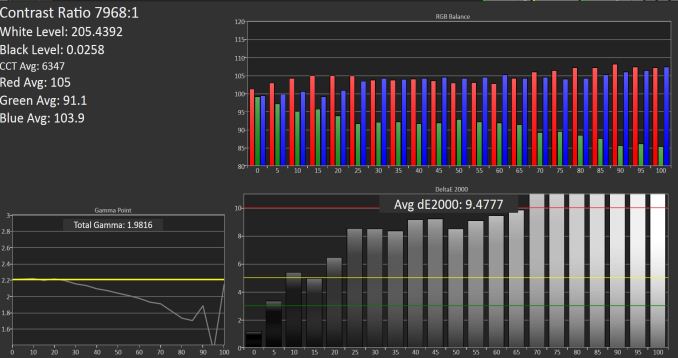

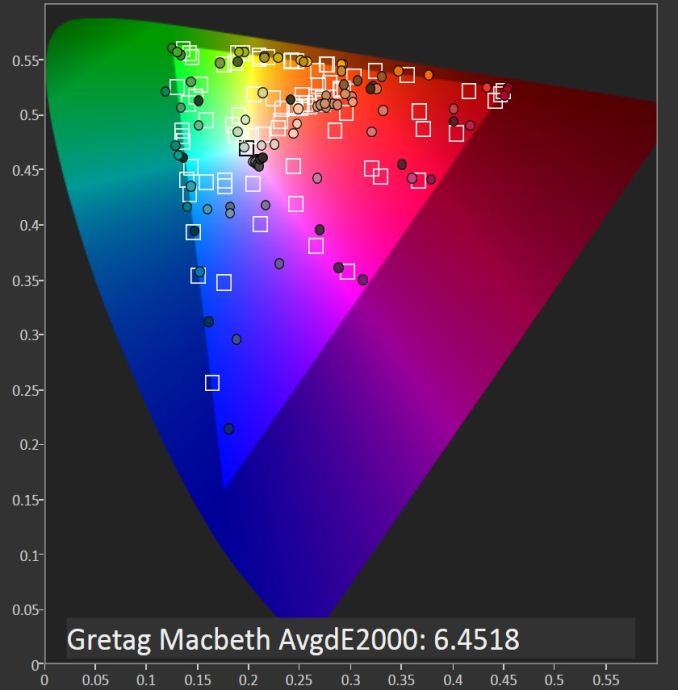












115 Comments
View All Comments
Arbie - Monday, September 8, 2014 - link
SD police here...So my low-end Nokia 520 has microSD, which lets me easily swap in TV series that I watch when traveling or to kill time waiting somewhere. A new 930 at much higher price won't let me do that.
Hmmm... my love affair with Nokia (the 520 is great) will be coming to an end.
Windows Phone doesn't even have the flimsy excuses of the Android camp for no SD. It can even be read-only dumb storage, with no security issues. But no.
Not interested / will never buy it.
tuxRoller - Monday, September 8, 2014 - link
The Android issues aren't with security but, from what a Dev claimed (falsely, IMO) poor user experience.NikAwesome - Tuesday, September 9, 2014 - link
SD, mSD or whatever external storage are at least an order of magnitude slower than eMMC or ONFI or more advanced NAND interfaces. When an application like the Photo Gallery browser has to read lots of pictures from SD it is really a torture (several seconds, or tens of seconds). In the first eras of tablets and smartphones, people get accustomed that all has to launch in less than second (give or take), faster than their desktop application launch at home/work. So in this context, several seconds is inappropiately interpreted as sluggish CPU performance when the real bottleneck is in the storage IOs. These delays severely impact usability if you are used to full internal flash storage, where everything opens in under a second.I am not against mSD cards, I have an 8GB S4 mini and 32 GB mSD. I can easily tell the performance difference, but I have no choice if I want to take lots of pictures or film lost of 1080p videos.
Summing up, performance is the real reason why Google do not allow external storage on their devices (Nexus smartphones and tablets). From Apple point of view is arguable that they had contracts with music label records inheriting the iPod policy: "easy to load music into the device, a pain in the ass to extract it in order to make piracy more difficult"
jimbo2779 - Tuesday, September 9, 2014 - link
If you think sd cards make viewing photos on a phone a chore them it could be your phone or its support of SD cards that is at fault on the Lumia 620 there is no noticeable difference between photos on the phone memory and in SD card.Also there seems to be very little difference, if any, between the 620with all pics on SD and a925 with no SD support so speed is not a reason.
tobi1449 - Tuesday, September 9, 2014 - link
Plus: What's worse, photos that take a little bit longer to load or photos that either don't load at all because you don't have them with you or take much much longer and half of your free data?marcokatz - Friday, September 26, 2014 - link
Well Nokia sure is trying, but Microsoft is not exactly helping them out (they even released their own app for iPhone first... gosh). Anyway, as of today it's much better to go for one of the really good Android phones. /Marco from http://www.consumertop.com/best-phone-guide/tuxRoller - Tuesday, September 9, 2014 - link
That wasn't the reason given, iirc. The problem he mentioned was one of user removes sdcard, doesn't see his photos/apps on phone and gets confused. The other issue was technical, but, again iirc, was fixable if they wanted.jimbo2779 - Tuesday, September 9, 2014 - link
While that is the one technical issue with SD card implementation I would say there is a very small amount of people that would be able / willing to switch out the SD card and not be aware that they would be missing the contents of that SD card when they go into their photos app.When you remove a DVD from your computer do you wonder why you can't watch your favourite film anymore? Would anyone?
I am sure it has happened to someone at some point but realistically how many people would that affect compared to the amount of people that would put an extra 32 or 64 Gb in their phone and just be happy to have doubled or tripled their storage to keep a years worth of photos and videos of their kids on their phone.
Either way you look at it having the option to massively extend the amount of internal storage to have more media / apps in your phone is more favourable to most compared to having to resort to the cloud (which is just a no-go for a good portion of smartphone users across the world) or constantly removing stuff to make the newest stuff fit.
I would miss Glance but without SD card I will not be buying this which is a shame I was looking forward to it, don't even get me started on how the rumours for the 830 got me all excited and left me disappointed when the phone was finally announced. Either the 830 or 930 could have been WP halo phones for a lot of potential detractors to the WP platform, instead they are just a few tweaks short of stacking up very favourably with their android competition.
tuxRoller - Tuesday, September 9, 2014 - link
The technical issue was actually brought up by the poster below me (pjcamp). It was regarding creating a unified storage space across multiple devices.To be clear, I am NOT saying these were good reasons, I only brought them up in response to the parent who I thought MIGHT have been claiming that the reasons android dropped sd card support was related to security.
I really wish that sdcards (or some other removable storage standard) made a comeback on android.
Rama TT - Saturday, September 13, 2014 - link
"""Summing up, performance is the real reason why Google do not allow external storage on their devices "" Yeah right and it has nothing to do with Google Drive